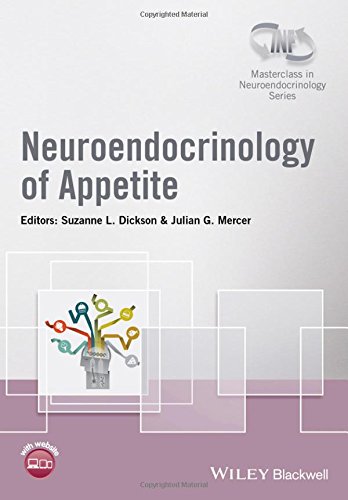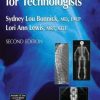Neuroendocrinology of Appetite Wiley INF Masterclass in Neuroendocrinology Series 1st Edition by Suzanne L Dickson, Julian G Mercer ISBN 1118839323 978-1118839324
$50.00 Original price was: $50.00.$35.00Current price is: $35.00.
Neuroendocrinology of Appetite Wiley INF Masterclass in Neuroendocrinology Series 1st Edition by Suzanne L Dickson, Julian G Mercer – Ebook PDF Instant Download/Delivery:1118839323, 978-1118839324
Full download Neuroendocrinology of Appetite Wiley INF Masterclass in Neuroendocrinology Series 1st Edition after payment

Product details:
ISBN 10: 1118839323
ISBN 13: 978-1118839324
Author: Suzanne L. Dickson, Julian G. Mercer
This cutting-edge, interdisciplinary volume describes established and state of the art approaches for exploring the pathways that influence and control appetite, including: behavioural, electrophysiological, neuroanatomical, gene knockout and pharmacological techniques. The book presents key peptide and neurotransmitter systems, together with newly emerging concepts of metabolic signalling and hypothalamic inflammation. The impact of early life experience on neuroendocrine appetite circuits is also looked at, including early programming of these circuits by circulating hormones. Finally, new emerging therapeutic approaches to appetite suppression are discussed, including those linked to bariatric (weight loss) surgery.
Neuroendocrinology of Appetite is especially focused on established and emerging technologies and approaches for investigating appetite control. It is written so as to provide an overview of sufficient depth for an undergraduate or new scientist in the field to come up to speed in the complementary approaches used by researchers in this field. Taking an interdisciplinary approach, the book aims to appeal to all those with a basic, clinical or therapeutic interest in research into obesity and eating disorders.
Table of contents:
CHAPTER 1: Neuroanatomy of Feeding Pathways
Introduction
1.1 Historical background and perspectives
1.2 The arcuate nucleus, an important hub but not the last word in hypothalamic feeding-related pathways
1.3 Other hypothalamic feeding centers – downstream or not?
1.4 Reward-based feeding pathways – interactions between homeostatic and hedonistic neural pathways
1.5 Nodal integration of homeostatic and hedonic feeding pathways
1.6 The importance of distributed neural networks extending to the brainstem
1.7 Perspectives
Glossary
Cited references
Further recommended reading
CHAPTER 2: Afferent Endocrine Control of Eating
Introduction
2.1 Background
2.2 Gastrointestinal hormones that affect eating
2.3 Adiposity signals
2.4 Interactions among hormones – from single meals to energy homeostasis
2.5 Perspectives
Glossary
Cited references
Further recommended reading
CHAPTER 3: Ontogeny of Neuroendocrine Feeding Circuits
Introduction
3.1 Major stages of hypothalamic development
3.2 Developmental aspects of the hypothalamic response to metabolic hormones
3.3 Hormonal control of hypothalamic development
3.4 Development of appetite-related circuits in obesity-related conditions
3.5 Perspectives
Glossary
Cited references
CHAPTER 4: Hypothalamic Peptides and Meal Patterns
Introduction
4.1 Analysis of how animals feed
4.2 The hypothalamus and feeding-related behavior
4.3 Neuropeptides involved in feeding-related behavior
4.4 Peripheral peptides with central sites of action that affect food intake
4.5 Future perspectives
Glossary
Cited References
CHAPTER 5: Food Hedonics
Introduction
5.1 Food hedonics
5.2 Animal models of food hedonics
5.3 Excessive feeding: binge eating and food addiction
5.4 Hormonal regulation of food hedonics
5.5 Conclusions
5.6 Perspectives
Acknowledgements
Glossary
Cited references
CHAPTER 6: Functional and Anatomical Dissection of Feeding Circuits
Introduction
6.1 AgRP neuron circuits that regulate appetite
6.2 Second-order circuit nodes downstream of AgRP neurons
6.3 Third-order nodes downstream of AgRP neurons that elevate food intake
6.4 Circuits presynaptic to AgRP neurons
6.5 Perspectives
Glossary
Cited references
CHAPTER 7: Exploring Appetite and Hypothalamic Circuitry through Manipulating Gene Expression
Introduction
7.1 Genetics and obesity
7.2 Central control of energy balance
7.3 Transgenic technology basics
7.4 Temporal and spatial control of transgenic genes
7.5 CRISPR/Cas mediated genome engineering
7.6 Perspectives
Glossary
Cited references
Further recommended reading
CHAPTER 8: Electrophysiology of the Appetite-Regulating Circuits of the Hypothalamus
Introduction
8.1 Background
8.2 Gut–brain signaling
8.3 Central signaling
8.4 Electrophysiological studies of appetite signaling
8.5 Perspectives
Glossary
Cited references
Further recommended reading
CHAPTER 9: Functional Neuroimaging of Appetite and Gut–Brain Interactions
Introduction
9.1 Appetite and the brain
9.2 Functional neuroimaging techniques
9.3 Gut–brain interactions: appetite hormones versus brain responses
9.4 Perspectives
Glossary
Cited references
Further recommended reading
CHAPTER 10: Appetite Disorders
Introduction
10.1 Etiology of eating disorders
10.2 Eating disorders: subtypes and diagnosis
10.3 Animal models of eating disorders
10.4 Underlying mechanisms and targets for treatment
Glossary
Cited references
CHAPTER 11: Future Prospects of the Management of Appetite Disorders
Introduction
11.1 Historical perspective on bariatric surgery
11.2 Bariatric procedures
11.3 Neurobiological effects and mechanisms
11.4 Food preferences
11.5 New knowledge emerging
11.6 Conclusions
11.7 Perspectives
Glossary
Cited references
Further recommended reading
CHAPTER 12: Discovery of New Drugs for Weight Loss and Prevention of Weight Regain
Introduction
12.1 Background
12.2 The drug discovery process
12.3 Drug combinations in obesity
12.4 Multiselective therapeutics (MT)
12.5 The postobese state
12.6 Perspectives
People also search for:
neuroendocrinology
neuroendocrinology impact factor
neuroendocrinology rutgers
neuroendocrinology journals
Neuroendocrinology of Appetite Wiley INF Masterclass
Tags:
Suzanne L Dickson,Julian G Mercer,Neuroendocrinology,Appetite Wiley



